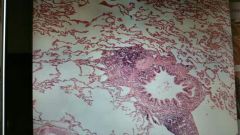![]()
![]()
![]()
Use LEFT and RIGHT arrow keys to navigate between flashcards;
Use UP and DOWN arrow keys to flip the card;
H to show hint;
A reads text to speech;
35 Cards in this Set
- Front
- Back
|
created by changing the size of the thoracic cavity, and therefore pulmonary cavities, by contracting or relaxing specific skeletal muscles. |
pressure differences |
|
|
increases the volume of the thoracic cavity, decreasing pressure, |
contraction of the diaphragm |
|
|
decreases the volume of the cavity, increasing pressure, therefore forcing air out of the balloons (expiration) |
relaxation of the diaphragm |
|
|
is the volume of air moved in OR out of the lung with each breath in normal quiet breathing |
Tidal Volume (TV) |
|
|
normal inhale, normal exhale, more forceful exhale |
Experatory Reserve Volume (ERV) |
|
|
forceful inhale, forceful exhale formula? |
Vital Capacity (VC) VC= TV + ERV + IRV |
|
|
quiet inhale, forceful inhale
|
Inspiratory Reserve Volume (IRV) |
|
|
Spirometer cannot determine IRV, what are the formulas needed to determine IRV |
IRV= VC - (TV + ERV) |
|
|
the amount of air left in the lungs after forceful expiration. ensures lungs do not collapse (keeps lungs open) |
Residual Volume (RV) |
|
|
breathing deeply and slowly |
hyperventilate |
|
|
no breathing |
apnea |
|
|
when a normal individual hyperventilates in fresh air, their blood carbon dioxide content decrease or increase? |
decreases |
|
|
decrease in blood carbon dioxide is followed by a decrease? increase? in the rate and depth of respirations |
decrease |
|
|
hyperventilation into the paper bar (re-breathing exhaled air) causes the blood carbon dioxide content to decrease? increase? |
increase |
|
|
an increase in blood carbon dioxide is followed by decrease? increase? in the rate and depth of respirations |
increase |
|
|
the subject was able to hold their breath longer when they did? did not? first hyperventilate (without a paper bag) |
they did |
|
|
the explanation for the result noted in the preceding answer is that hyperventilation decreases ___ content of blood so it takes longer for it to accumulate to the level necessary to stimulate respirations |
CO2 |
|
|
the rate and depth of respiration are directly? indirectly related to the amount of carbon dioxide in the blood. |
directly |
|
|
Normally when blood carbon dioxide content increases, respirations decrease? also increase? |
increase |
|
|
When blood carbon dioxide content decreases, respirations also decrease? increase? |
decrease |
|
|
contraction diaphragm |
1. increases size of thoracic cavity 2. decrease intrathoracic pressure 3. from 757 to 754 mmHg pressure 4. decrease alveoli pressure from 760 to 758 mmHg pressure air moves into lungs and inspiration occurs |
|
|
acts as a tube for the ventilation of the lungs |
organ trachea |
|
|
helps keeps trachea open at all times |
structure incomplete rings of hyaline cartilage |
|
|
hyaline cartilage are incomplete with the open part toward the esophagus, to ? |
facilitate swallowing |
|
|
produces mucous, which traps the particles and the cilia, moves the mucous layer up the trachea away from the lungs |
structure goblet cells |
|
|
branches into 2 tubes, entering each lung |
organ primary bronchi |
|
|
smaller tubes that distribute the air to all parts of the lung do not move large volumes of air, like the trachea, nots as prone to collapse wall contain progressively less cartilage |
structure bronchioles |
|
|
multitude of thin walled sacs surrounded by ? |
structure alveoli structure capillaries |
|
|
major respiratory muscle is a thin, dome shaped sheet of skeletal muscle which separates the thoracic and abdominopelvic cavity. |
diaphragm |
|
|
diaphragm increase the size of the thoracic cavity causing |
inspiration |
|
|
diaphragm relaxes the thoracic cavity decreases in size cauding |
expiration |
|

|
Trachea |
|

|
Lungs |
|

|
Bronchiole |
|

|
Diaphragm |

